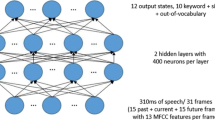There are two main requirements for embedded/mobile systems: one is low power consumption for long battery life and miniaturization, the other is low unit cost for components produced in very large numbers (cell phones, set-top boxes). Both requirements are addressed by CPU’s with integer-only arithmetic units which motivate the fixed-point arithmetic implementation of automatic speech recognition (ASR) algorithms. Large vocabulary continuous speech recognition (LVCSR) can greatly enhance the usability of devices, whose small size and typical on-the-go use hinder more traditional interfaces. The increasing computational power of embedded CPU’s will soon allow real-time LVCSR on portable and lowcost devices. This chapter reviews problems concerning the fixed-point implementation of ASR algorithms and it presents fixed-point methods yielding the same recognition accuracy of the floating-point algorithms. In particular, the chapter illustrates a practical approach to the implementation of the frame-synchronous beam-search Viterbi decoder, N-grams language models, HMM likelihood computation and mel-cepstrum front-end. The fixed-point recognizer is shown to be as accurate as the floating-point recognizer in several LVCSR experiments, on the DARPA Switchboard task, and on an AT&T proprietary task, using different types of acoustic front-ends, HMM’s and language models. Experiments on the DARPA Resource Management task, using the StrongARM-1100 206 MHz and the XScale PXA270 624 MHz CPU’s show that the fixed-point implementation enables real-time performance: the floating point recognizer, with floating-point software emulation is several times slower for the same accuracy.
Access this chapter
Tax calculation will be finalised at checkout
Purchases are for personal use only
Preview
Unable to display preview. Download preview PDF.
Similar content being viewed by others
References
Bocchieri, E. and Mak, B. (2001) Subspace distribution clustering hidden Markov model. IEEE Transactions on ASSP, vol. 9, pp. 264-275.
Davis, S.B. and Mermelstein, P. (1980) Comparison of parametric representations for mono-syllabic word recognition in continuously spoken sentences. IEEE Transactions on ASSP, vol. ASSP-28, no. 4, pp. 357-366.
Gong, Y. and Kao, Y. (2000) Implementing a high accuracy speaker-independent Continuous speech recognizer on a fixed-point DSP. In Proceedings of ICASSP, pp. 3686-3689.
Hermansky, H. and Morgan, N. (1994) Rasta processing of speech. IEEE Transaction on ASSP, vol. 6, pp. 578-589.
Huggins-Daines, D., Kumar, M., Chan, A., Black, A.W., Ravishankar, M. and Rudnicky, A.I. (2006) Pocketsphinx: A free, real-time continuous speech recognition system for hand-held devices. In Proceedings of ICASSP, vol. 1, pp. 185-188.
Jeong, J., Han, I., Jon, E. and Kim, J. (2004) Memory and computation reduction for embed-ded ASR systems. In Proceedings of ICSLP.
Kanthak, S., Schütz, K. and Ney, H. (2000) Using SIMD instructions for fast likelihood calcu-lation in LVCSR. In Proceedings of ICASSP, pp. 1531-1534.
Kao, Y.H. and Rajasekaran, P.K. (2000) A low cost dynamic vocabulary speechrecognizer on a GPP-DSP system. In Proceedings of ICASSP, pp. 3215-3218.
Köhler, T., Fügen, C., Stüker, S. and Waibel, A. (2005) Rapid porting of ASR systems to mobile devices. In Proceedings of INTERSPEECH, pp. 233-236.
Lee, K.F. (1989). Automatic Speech Recognition Recognition. The Development of the SPHINX System, Kluwer Academic.
Lee, L. and Rose, R.C. (1996) Speaker normalization using efficient frequency warping pro-cedures. In Proceedings of ICASSP, vol. 1, pp. 353-356.
Leppänen, J. and Kiss, I. (2005) Comparison of low foot-print acoustic modeling techniques for embedded ASR studies. In Proceedings of INTERSPEECH, pp. 2965-2968.
Li, X., Malkin, J. and Bilmes, J. (2006) A high-speed, low-resource ASR back-end based on custom arithmetic. IEEE Transaction on Speech and Audio Processing, vol. 14, issue 5, pp. 1683-1693.
Mohri, M., Pereira, F. and Riley, M. (2002) Weighted finite-state transducers in speech recog-nition. Computer, Speech and Language, vol. 16 issue 1, pp. 69-99.
Novak, M. (2004) Towards large vocabulary ASR on embedded platforms. In Proceedings of ICSLP.
Novak, M., Hampl, R., Krbec, P. and Sedivy, J. (2003) Two-pass search strategy for large list recognition on embedded speech recognition platforms. In Proceedings of ICASSP, vol. 1, pp. 200-203.
Oppenheim, A.V. and Schafer, R.W. (1975) Digital signal processing, Prentice-Hall.
Rose, R., Parthasarathy, S., Gajic, B., Rosenberg, A. and Narayanan S. (2001) On the imple-mentation of ASR algorithms for hand-held wireless mobile devices. In Proceedings of ICASSP, vol. 1, pp. 17-20.
Sagayama, S. and Takahashi, S. (1995) On the use of scalar quantization for fast HMM com-putation. In Proceedings of ICASSP, Vol. 1, pp. 213-216.
Saon, G., Padmanabhan, M., Gopinath, R., and Chen, S. (2000) Maximum likelihood dis-criminant feature spaces. In Proceedings of ICASSP, vol. 2, pp. 1129-1131.
Vasilache, M. (2000) Speech recognition using HMM’s with quantized parameters. In Pro-ceedings of ICSLP, vol. 1, pp. 441-444.
Vasilache, M., Iso-Sipilä, J. and Viikki, O. (2004) On a practical design of a ow complexity speech recognition engine. In Proceedings of ICASSP, vol. 5, pp. V-113-16.
Viikki, O. (2001) ASR in portable wireless devices. In Proceedings of ASRU, pp. 96-99.
Zaykovskiy, D. (2006) Survey of the speech recognition techniques for mobile devices. In Proceedings of 11th International Conference Speech and Computer, SPECOM’2006, pp. 88-92.
Author information
Authors and Affiliations
Rights and permissions
Copyright information
© 2008 Springer-Verlag London Limited
About this chapter
Cite this chapter
Bocchieri, E. (2008). Fixed-Point Arithmetic. In: Automatic Speech Recognition on Mobile Devices and over Communication Networks. Advances in Pattern Recognition. Springer, London. https://doi.org/10.1007/978-1-84800-143-5_12
Download citation
DOI: https://doi.org/10.1007/978-1-84800-143-5_12
Publisher Name: Springer, London
Print ISBN: 978-1-84800-142-8
Online ISBN: 978-1-84800-143-5
eBook Packages: Computer ScienceComputer Science (R0)




